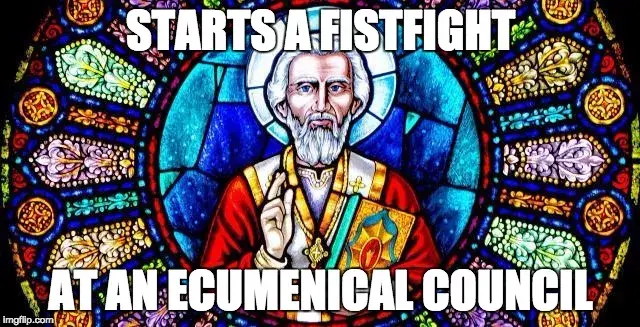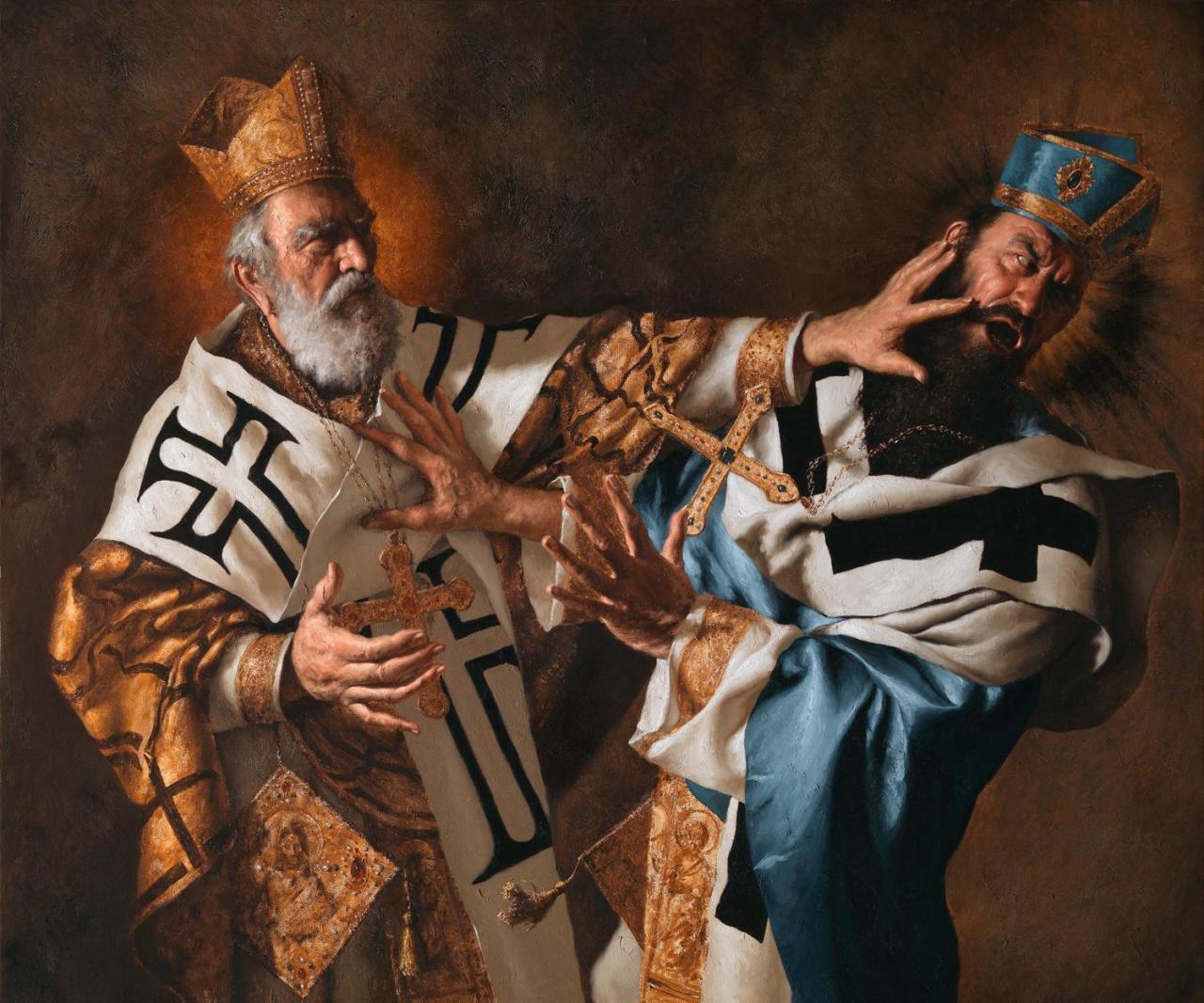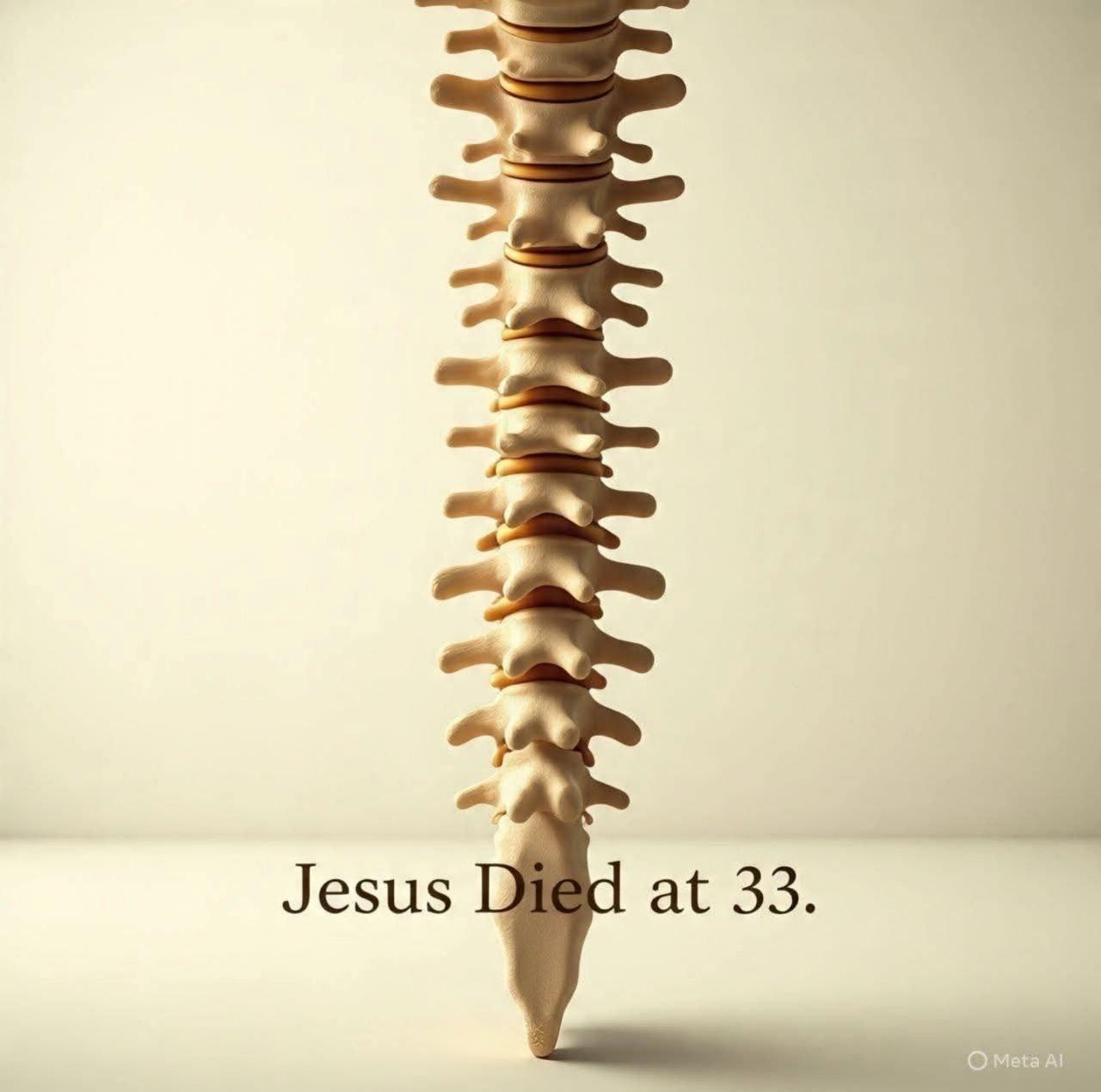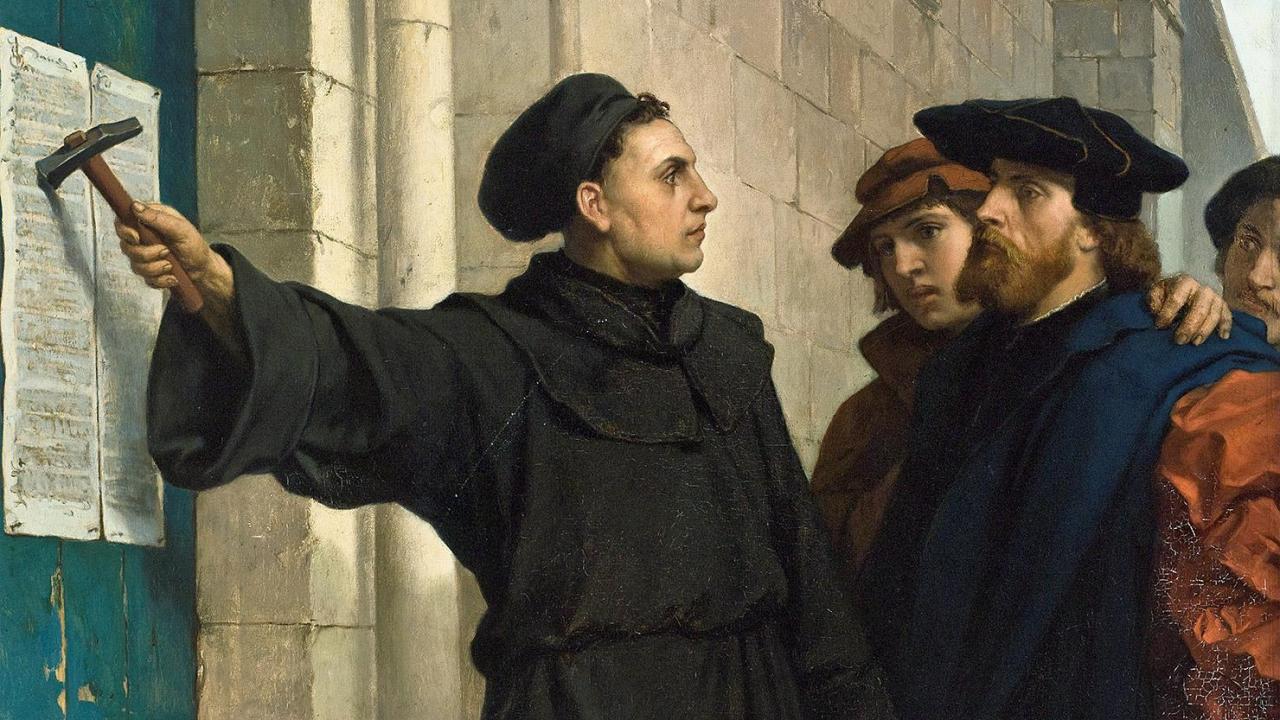From Paradise to Presents: The Christian Story Behind the Christmas Tree

The Christmas tree is one of the most recognisable symbols of the festive season, adorning homes, churches, and public spaces with its evergreen beauty. But where did this tradition originate, and how did it become a central feature of Christmas celebrations? Looking into the history of the Christmas tree has turned out to be a fascinating historical story woven from various cultural and theological strands.
The Paradise Tree and the Feast of Adam and Eve
The connection between the Christmas tree and the Feast of Adam and Eve offers a large clue into its origins. In medieval Europe, December 24th was observed as the feast day of Adam and Eve, a commemoration tied to their expulsion from Eden. One of the most notable elements of this feast was the “Paradise Tree,” used in mystery plays and home displays to symbolise the Tree of Knowledge in the Garden of Eden.
These trees, typically evergreen, were decorated with apples to represent the forbidden fruit and wafers symbolising the Eucharist. This imagery reflected both humanity’s fall into sin and God’s redemptive plan through Christ. The Paradise Tree served as a visual catechism of sorts, teaching the story of salvation from the Fall to the Redemption. In a later tradition the wafers were replaced by cookies of various shapes, and candles, symbolic of Jesus as the light of the world, were often added to the trees.
Pre-Christian Traditions and the Evergreen
Evergreens have long been associated with life and resilience in the darkest days of winter. In pre-Christian European traditions, evergreen boughs were used during festivals like the Roman Saturnalia and the Germanic Yule. These practices celebrated the endurance of life through the cold and darkness, offering hope of the spring to come. While these customs were not inherently Christian, they provided a cultural framework that could be adapted to Christian theology.
The evergreen tree, in this context, became a symbol of eternal life in Christ, as suggested by John 10:28: “I give them eternal life, and they will never perish.”
Martin Luther and the Candlelit Tree
A significant figure in the history of the Christmas tree is the Reformer Martin Luther. According to tradition, Luther was struck by the beauty of a starry winter sky shining through the branches of an evergreen tree. To share this moment of wonder with his family, he brought a tree into his home and decorated it with candles to represent Christ as the “Light of the World” (John 8:12).
While this story is likely apocryphal, it reflects the theological connection Christians saw in the evergreen tree as a symbol of Christ’s enduring presence and light in the darkness. Luther’s influence in Protestant Germany may have helped popularise the use of Christmas trees in Christian households.
The Spread of the Christmas Tree
The tradition of the Christmas tree gained popularity in Germany during the 16th and 17th centuries. By the 18th and 19th centuries, German immigrants brought the custom to other parts of Europe and North America. One pivotal moment in its wider adoption was the depiction of Queen Victoria and Prince Albert around a decorated Christmas tree in an illustration published in the Illustrated London News in 1848.
This royal endorsement sparked a surge in the tradition’s popularity, particularly in Britain, where it came to symbolise the domestic warmth and joy of the holiday season.

St. Boniface and the Sacred Oak
One of the most compelling narratives about the Christmas tree’s origins involves St. Boniface, an English missionary whose evangelistic efforts in 8th-century Germany played a pivotal role in shaping this enduring custom. According to tradition, Boniface encountered a group of pagans venerating an oak tree dedicated to Thor, the Norse god of thunder. In a bold act to demonstrate the supremacy of the Christian God, Boniface felled the sacred oak. Amazingly, as the oak crashed to the ground, it split into four parts, revealing a young fir tree at its centre. Seizing this moment, Boniface proclaimed the fir tree as the new symbol of faith, pointing to its evergreen nature as a representation of eternal life in Christ. He is said to have declared:
“This little tree, a young child of the forest, shall be your holy tree tonight. It is the wood of peace… It is the sign of an endless life, for its leaves are ever green. See how it points upward to heaven. Let this be called the tree of the Christ-child; gather about it, not in the wild wood, but in your own homes; there it will shelter no deeds of blood, but loving gifts and rites of kindness.”
This powerful imagery resonated with the local populace, facilitating their conversion to Christianity and embedding the fir tree into Christian symbolism.

Theological Significance
The evergreen nature of the fir tree symbolises the eternal life offered through Christ, remaining green amidst the winter’s barrenness. The triangular shape of the tree has been interpreted to represent the Holy Trinity, as well as a symbol pointing us upward towards heaven, further enriching its theological significance. As St. Boniface’s legend illustrates, the transformation of a pagan symbol into a Christian one exemplifies the Church’s mission to redeem and sanctify cultural practices, directing them towards the glorification of God.
A Tree of Redemption and Hope
The Christmas tree today is more than just a festive decoration; it is a symbol rich with theological meaning, even if most of it has been stripped away by the rampant secularisation and commercialisation of the holiday. Its evergreen branches remind us of the eternal life offered in Christ. The tradition of decorating the tree with lights and ornaments can reflect the hope and joy of Christ’s coming into the world. As Christians, we are called to remember the deeper story behind this beloved tradition. From the Paradise Tree of medieval mystery plays to Luther’s candlelit tree, the Christmas tree is a symbol of God’s redemptive work, shining light into the darkness of our world.
In the words of Isaiah 60:1: “Arise, shine; for your light has come, and the glory of the Lord has risen upon you.”
The Jeremiah 10 Debate: Idolatry or Tradition?
The Christmas tree has been the subject of much debate, with some questioning whether it has biblical support or condemnation. One of the most frequently cited passages in these discussions is Jeremiah 10:1–5. Some claim that these verses condemn the use of Christmas trees, but a closer look reveals that the text is not addressing this tradition at all.
Reading Jeremiah in Context
What Does Jeremiah 10:1–5 Say? The passage reads:
Hear the word that the Lord speaks to you, O house of Israel. Thus says the Lord:
Do not learn the way of the nations,
or be dismayed at the signs of the heavens;
for the nations are dismayed at them.
For the customs of the peoples are false:
a tree from the forest is cut down,
and worked with an axe by the hands of an artisan;
people deck it with silver and gold;
they fasten it with hammer and nails
so that it cannot move.
Their idols are like scarecrows in a cucumber field,
and they cannot speak;
they have to be carried,
for they cannot walk.
Do not be afraid of them,
for they cannot do evil,
nor is it in them to do good.
At first glance, the mention of cutting down a tree, decorating it with gold and silver, and securing it in place might seem to describe a Christmas tree if you take a very surface level reading of the text, devoid of context. However, a deeper understanding of the context makes it clear that Jeremiah is not addressing holiday decorations but the creation of idols.
Jeremiah and Idolatry
Jeremiah’s primary concern in this passage is idolatry — specifically, the practice of carving wooden idols from trees and adorning them with precious metals to be worshipped as gods. The phrase “worked with an axe by the hands of an artisan” and the description of these objects being “like scarecrows” underscore that these trees were not left in their natural state but were fashioned into idols.

The text also emphasises the futility of these idols: they cannot speak, walk, or act. This critique aligns with other biblical denunciations of idolatry, such as Isaiah 44:9–20, which similarly mocks the idea of worshipping a lifeless object crafted by human hands.
Context is Key
Jeremiah 10:1–5 is not a condemnation of the Christmas tree but a warning against idolatry. To claim otherwise is anachronistic and to misinterpret both the historical and theological context of the passage, and project modern ideas back into the text. The Christmas tree, far from being an idol, is a beautiful example of how Christians have used natural wonders to symbolise and reflect on their faith.
The Christmas Tree is NOT an Idol
The Christmas tree, as it is used today, has no association with idolatry or pagan worship. Instead, it is a symbol of Christian hope and eternal life, as its evergreen nature points to the unchanging promises of God. Moreover, the tradition of decorating a Christmas tree has always been intended as an act of celebration, not veneration, centred around a Biblical story and Jesus.
It is important to distinguish between cultural symbols that are used to glorify God and the idolatrous practices condemned in Scripture. As Paul writes in 1 Corinthians 10:31, “So, whether you eat or drink, or whatever you do, do everything for the glory of God.” The Christmas tree, when used in a Christ-centred way, serves as a joyful reminder of Christ’s coming and the light He brings into the world.
Conclusion
The Christmas tree stands today as a testament to the enduring legacy of Christian faith and ingenuity. Its rich history — from the Paradise Tree to St. Boniface’s missionary efforts and beyond — reflects the transformative power of Christ’s redemption. As we adorn our trees this Christmas, let us celebrate not only the joy of the season but also the eternal hope and light found in Jesus Christ.
Further Reading
- Mystery play — Wikipedia
- Does Christmas have pagan origins? | The Sacred Faith: Timeless Truths for Modern Minds
- Christmas tree | Tradition, History, Decorations, Symbolism, & Facts | Britannica
- Saint Boniface — World History Encyclopedia
- St. Boniface and the Christmas Tree | Catholic Answers Magazine
- Proof of life-size statues of Canaanite god unveiled in biblical Lachish — Israel News — The Jerusalem Post
Leave a comment Like Back to Top Seen 489 times Liked 0 times
Enjoying this content?
Support my work by becoming a patron on Patreon!
By joining, you help fund the time, research, and effort that goes into creating this content — and you’ll also get access to exclusive perks and updates.
Even a small amount per month makes a real difference. Thank you for your support!
Subscribe to Updates
If you enjoyed this, why not subscribe to free email updates and join over 864 subscribers today!
My new book is out now! Order today wherever you get books
Recent Posts
Luke J. Wilson | 19th August 2025 | Fact-Checking
A poetic post has been circulating widely on Facebook, suggesting that our anatomy mirrors various aspects of Scripture. On the surface it sounds inspiring, but when we take time to weigh its claims, two main problems emerge. The viral post circulating on Facebook [Source] First, some of its imagery unintentionally undermines the pre-existence of Christ, as if Jesus only “held the earth together” for the 33 years of His earthly life. Second, it risks reducing the resurrection to something like biological regeneration, as if Jesus simply restarted after three days, instead of being raised in the miraculous power of God. Alongside these theological dangers, many of the scientific claims are overstated or symbolic rather than factual. Let’s go through them one by one. 1. “Jesus died at 33. The human spine has 33 vertebrae. The same structure that holds us up is the same number of years He held this Earth.” The human spine does generally have 33 vertebrae, but that number includes fused bones (the sacrum and coccyx), and not everyone has the same count. Some people have 32 or 34. More importantly, the Bible never says Jesus was exactly 33 when He died — Luke tells us He began His ministry at “about thirty” (Luke 3:23), and we know His public ministry lasted a few years, but His precise age at death is a tradition, not a biblical statement. See my other recent article examining the age of Jesus here. Theologically, the phrase “the same number of years He held this Earth” is problematic. Jesus did not hold the world together only for 33 years. The eternal Word was with God in the beginning (John 1:1–3), and “in Him all things hold together” (Colossians 1:17). Hebrews says He “sustains all things by His powerful word” (Hebrews 1:3). He has always upheld creation, before His incarnation, during His earthly ministry, and after His resurrection. To imply otherwise is to risk undermining the pre-existence of Christ. 2. “We have 12 ribs on each side. 12 disciples. 12 tribes of Israel. God built His design into our bones.” Most people do have 12 pairs of ribs, though some are born with an extra rib, or fewer. The number 12 is certainly biblical: the 12 tribes of Israel (Genesis 49), the 12 apostles (Matthew 10:1–4), and the 12 gates and foundations of the New Jerusalem (Revelation 21). But there’s no biblical connection between rib count and these symbolic twelves. This is a case of poetic association, not design woven into our bones. The only real mention of ribs in Scripture is when Eve is created from one of Adam’s ribs in Genesis 2:21–22, which has often led to the teaching in some churches that men have one less rib than women (contradicting this new claim)! 3. “The vagus nerve runs from your brain to your heart and gut. It calms storms inside the body. It looks just like a cross.” The vagus nerve is real and remarkable. It regulates heart rate, digestion, and helps calm stress, and doctors are even using vagus nerve stimulation as therapy for epilepsy, depression, and inflammation showing it really does “calm storms” in the body. But it does not look like a cross anatomically. The language about “calming storms” may echo the way Jesus calmed the storm on the Sea of Galilee (Mark 4:39), but here again the poetic flourish stretches science (and Scripture) beyond what’s accurate. 4. “Jesus rose on the third day. Science tells us that when you fast for 3 days, your body starts regenerating. Old cells die. New ones are born. Healing begins. Your body literally resurrects itself.” There’s a serious theological problem here. To equate Jesus’ resurrection with a biological “regeneration” after fasting is to misrepresent what actually happened. Fasting can indeed trigger cell renewal and immune repair, but it cannot bring the dead back to life. It’s still a natural process that happens...
Luke J. Wilson | 08th July 2025 | Islam
“We all worship the same God”. Table of Contents 1) Where YHWH and Allah Appear Similar 2) Where Allah’s Character Contradicts YHWH’s Goodness 3) Where Their Revelations Directly Contradict Each Other 4) YHWH’s Love for the Nations vs. Allah’s Commands to Subjugate 5) Can God Be Seen? What the Bible and Qur’an Say 6) Salvation by Grace vs. Salvation by Works Conclusion: Same God? Or Different Revelations? You’ve heard it from politicians, celebrities, and even some pastors. It’s become something of a modern mantra, trying to shoehorn acceptance of other beliefs and blend all religions into one, especially the Abrahamic ones. But what if the Bible and Qur’an tell different stories? Let’s see what their own words reveal so you can judge for yourself. This Tweet recently caused a stir on social media 1) Where YHWH and Allah Appear Similar Many point out that Jews, Christians, and Muslims share a belief in one eternal Creator God. That’s true — up to a point. Both the Bible and Qur’an describe God as powerful, all-knowing, merciful, and more. Here’s a list comparing some of the common shared attributes between YHWH and Allah, with direct citations from both Scriptures: 26 Shared Attributes of YHWH and Allah According to the Bible (NRSV) and the Qur’an Eternal YHWH: “From everlasting to everlasting you are God.” — Psalm 90:2 Allah: “He is the First and the Last…” — Surah 57:3 Creator YHWH: “In the beginning God created the heavens and the earth.” — Genesis 1:1 Allah: “The Originator of the heavens and the earth…” — Surah 2:117 Omnipotent (All-Powerful) YHWH: “Nothing is too hard for you.” — Jeremiah 32:17 Allah: “Allah is over all things competent.” — Surah 2:20 Omniscient (All-Knowing) YHWH: “Even before a word is on my tongue, O LORD, you know it.” — Psalm 139:4 Allah: “He knows what is on the land and in the sea…” — Surah 6:59 Omnipresent (Present Everywhere) YHWH: “Where can I go from your Spirit?” — Psalm 139:7–10 Allah: “He is with you wherever you are.” — Surah 57:4 Holy YHWH: “Holy, holy, holy is the LORD of hosts.” — Isaiah 6:3 Allah: “The Holy One (Al-Quddus).” — Surah 59:23 Just YHWH: “A God of faithfulness and without injustice.” — Deuteronomy 32:4 Allah: “Is not Allah the most just of judges?” — Surah 95:8 Merciful YHWH: “The LORD, merciful and gracious…” — Exodus 34:6 Allah: “The Most Gracious, the Most Merciful.” — Surah 1:1 Compassionate YHWH: “As a father has compassion on his children…” — Psalm 103:13 Allah: “He is the Forgiving, the Affectionate.” — Surah 85:14 Faithful YHWH: “Great is your faithfulness.” — Lamentations 3:22–23 Allah: “Indeed, the promise of Allah is truth.” — Surah 30:60 Unchanging YHWH: “For I the LORD do not change.” — Malachi 3:6 Allah: “None can change His words.” — Surah 6:115 Sovereign YHWH: “The LORD has established his throne in the heavens…” — Psalm 103:19 Allah: “Blessed is He in whose hand is dominion…” — Surah 67:1 Loving YHWH: “God is love.” — 1 John 4:8 Allah: “Indeed, my Lord is Merciful and Affectionate (Al-Wadud).” — Surah 11:90 Forgiving YHWH: “I will not remember your sins.” — Isaiah 43:25 Allah: “Allah forgives all sins…” — Surah 39:53 Wrathful toward evil YHWH: “The LORD is a jealous and avenging God…” — Nahum 1:2 Allah: “For them is a severe punishment.” — Surah 3:4 One/Unique YHWH: “The LORD is one.” — Deuteronomy 6:4 Allah: “Say: He is Allah, One.” — Surah 112:1 Jealous of worship YHWH: “I the LORD your God am a jealous God.” �...
Luke J. Wilson | 05th June 2025 | Blogging
As we commemorated the 500th anniversary of the Protestant Reformation this year, the familiar image of Martin Luther striding up to the church door in Wittenberg — hammer in hand and fire in his eyes — has once again taken centre stage. It’s a compelling picture, etched into the imagination of many. But as is often the case with historical legends, closer scrutiny tells a far more nuanced and thought-provoking story. The Myth of the Door: Was the Hammer Ever Raised? Cambridge Reformation scholar Richard Rex is one among several historians who have challenged the romanticised narrative. “Strangely,” he observes, “there’s almost no solid evidence that Luther actually went and nailed them to the church door that day, and ample reasons to doubt that he did.” Indeed, the first image of Luther hammering up his 95 Theses doesn’t appear until 1697 — over 180 years after the fact. Eric Metaxas, in his recent biography of Luther, echoes Rex’s scepticism. The earliest confirmed action we can confidently attribute to Luther on 31 October 1517 is not an act of public defiance, but the posting of two private letters to bishops. The famous hammer-blow may never have sounded at all. Conflicting Accounts Philip Melanchthon, Luther’s successor and first biographer, adds another layer of complexity. He claimed Luther “publicly affixed” the Theses to the door of All Saints’ Church, but Melanchthon wasn’t even in Wittenberg at the time. Moreover, Luther himself never mentioned posting the Theses publicly, even when recalling the events years later. Instead, he consistently spoke of writing to the bishops, hoping the matter could be addressed internally. At the time, it was common practice for a university disputation to be announced by posting theses on church doors using printed placards. But no Wittenberg-printed copies of the 95 Theses survive. And while university statutes did require notices to be posted on all church doors in the city, Melanchthon refers only to the Castle Church. It’s plausible Luther may have posted the Theses later, perhaps in mid-November — but even that remains uncertain. What we do know is that the Theses were quickly circulated among Wittenberg’s academic elite and, from there, spread throughout the Holy Roman Empire at a remarkable pace. The Real Spark: Ink, Not Iron If there was a true catalyst for the Reformation, it wasn’t a hammer but a printing press. Luther’s Latin theses were swiftly reproduced as pamphlets in Basel, Leipzig, and Nuremberg. Hundreds of copies were printed before the year’s end, and a German translation soon followed, though it may never have been formally published. Within two weeks, Luther’s arguments were being discussed across Germany. The machinery of mass communication — still in its relative infancy — played a pivotal role in what became a theological, political, and social upheaval. The Letters of a Conscientious Pastor Far from the bold revolutionary of popular imagination, Luther appears in 1517 as a pastor deeply troubled by the abuse of indulgences, writing with respectful concern to those in authority. In his letter to Archbishop Albrecht of Mainz, he humbly addresses the archbishop as “Most Illustrious Prince,” and refers to himself as “the dregs of humanity.” “I, the dregs of humanity, have so much boldness that I have dared to think of a letter to the height of your Sublimity,” he writes — hardly the voice of a man trying to pick a fight. From Whisper to Roar Luther’s initial appeal through formal channels was, predictably, ignored. He was advised not to make trouble. But as opposition mounted and corruption remained unchecked, the once quiet reformer grew louder. His theological convictions deepened, and his public persona evolved. The lion did eventually roar — but not on October 31. A Catholic Reformer, Not a Protestant Founder It’s vital to remem...
Luke J. Wilson | 20th May 2025 | Islam
You are not alone. Around the world, many Muslims — people who already believe in one God, pray, and seek to live righteously — are drawn to know more about Jesus (ʿĪsā in Arabic). Some have heard He is more than a prophet. Some have sensed His presence in a dream or vision. And some simply long to know God more deeply, personally, and truly. So what does it mean to become a Christian? And how can you take that step? This guide is for you. 1. What Christians Believe About God and Jesus ➤ One God, Eternal and Good Christians believe in one God — the same Creator known to Abraham, Moses, and the prophets. But we also believe God is more personal and relational than many realise. In His love, He has revealed Himself as Father, Son (Jesus), and Holy Spirit — not three gods, but one God in three persons. ➤ Jesus Is More Than a Prophet Muslims honour Jesus as a great prophet, born of the virgin Mary. Christians also affirm this — but go further. The Bible teaches that Jesus is the Word of God (Kalimat Allāh), who became flesh to live among us. He performed miracles, healed the sick, raised the dead — and lived without sin.Jesus came not just to teach but to save — to bring us back to God by bearing our sins and rising again in victory over death. 2. Why Do We Need Saving? ➤ The Problem: Sin All people — no matter their religion — struggle with sin. We lie, get angry, feel jealous, act selfishly, or fail to love God fully. The Bible says: “All have sinned and fall short of the glory of God.” (Romans 3:23) Sin separates us from God. And no matter how many good deeds we do, we can never make ourselves perfect or holy before Him. ➤ The Solution: Jesus Because God loves us, He did not leave us in our sin. He sent Jesus, His eternal Word, to live as one of us. Jesus died willingly, offering His life as a sacrifice for our sins, then rose again on the third day. “But God proves his love for us in that while we still were sinners Christ died for us.” (Romans 5:8) 3. How Do I Become a Christian? Becoming a Christian is not about joining a Western religion. It’s about entering a relationship with God through faith in Jesus Christ. Here is what the Bible says: ✝️ 1. Believe in Jesus Believe that Jesus is the Son of God, that He died for your sins, and that He rose again. “If you confess with your lips that Jesus is Lord and believe in your heart that God raised him from the dead, you will be saved.” (Romans 10:9) 💔 2. Repent of Your Sins Turn away from sin and ask God to forgive you. This is called repentance. It means being truly sorry and choosing a new way. “Repent therefore, and turn to God so that your sins may be wiped out.” (Acts 3:19) 💧 3. Be Baptised Jesus commands His followers to be baptised in water as a sign of their new life. Baptism represents washing away your old life and rising into a new one with Jesus. “Repent and be baptised every one of you in the name of Jesus Christ so that your sins may be forgiven.” (Acts 2:38) 🕊️ 4. Receive the Holy Spirit When you believe in Jesus, God gives you the Holy Spirit to live within you, guiding you, comforting you, and helping you follow His will. “You received the Spirit of adoption, by whom we cry, ‘Abba! Father!’” (Romans 8:15) 🧎 5. Begin a New Life As a Christian, you are born again — spiritually renewed. You begin to grow in faith, love, and holiness. You read the Bible, pray, fast, and gather with other believers. Your life is no longer your own; you now live for God. 4. What Does a Christian Life Look Like? Jesus said: “If anyone wants to become my followers, let them deny themselves and take up their cross and follow me.” (Matthew 16:24) This means: Loving God with all your heart Loving your neighbour — even your enemies Forgiving others ...









